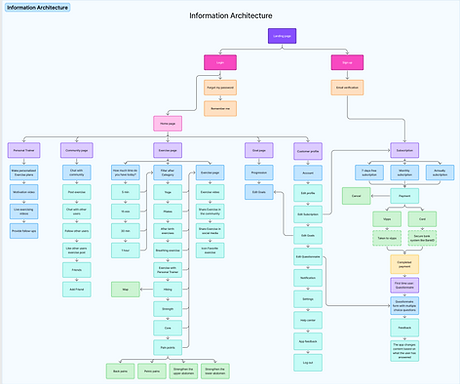StrongMama app

Duration
3 months
Project type
Mobile app
Year
2025
Location
Asker
Role
UX Designer
About assignment
This project was our course assignment when studying UX Design at Noroff School of Technology and Digital Media. Our task was to research, design, and test a digital product that addressed a real-world challenge. My team UxMamas — four mothers with recent postnatal experience, created StrongMama, a postnatal exercise app to support new mothers in regaining confidence, strength, and wellbeing after childbirth.
Note: We designed wireframes for onboarding, sign-up, and exercise pages. In this case study, I’ve chosen to highlight a glimpse of onboarding and focus mainly on the exercise flows.

Problem Statement
Busy mothers of young children struggle to make time for exercise in their daily lives, often neglecting their physical and mental health. The main barriers are lack of time, limited support, fluctuating motivation, and the absence of easy and accessible solutions.

Contributing to the app’s information architecture to ensure a clear and user-friendly structure.
Our mission
Our mission was to create a safe, motivating, and accessible fitness solution tailored to new mothers. We wanted StrongMama to empower women to fit exercise into their unpredictable schedules, provide professional guidance to avoid injuries, and foster confidence and wellbeing through short, effective, and realistic workouts.
The Progress
Our process followed the Design Thinking model:
-
Empathize & Research: We conducted literature reviews, competitive analysis, and interviews with new mothers to uncover needs, motivations, and challenges.
-
Define: We crafted a persona, Caroline Foster, to represent our users, and refined our problem statement.
-
Ideate: We used mind mapping, brainwriting, mood boards, and dot voting to generate and prioritize ideas.
-
Prototype: We created wireframes and concept sketches based on our most promising solutions.
-
Test: We ran usability tests with four participants from our target group to validate the prototype, gather insights, and iterate.

Brainwriting workshop — we used this technique to generate and build on new ideas collaboratively.
User flow - exercise
Our exercise user flow — outlining the steps from selecting to completing a workout.

Usability test
To validate our StrongMama prototype, we conducted a series of moderated usability tests with four participants from our target group — busy mothers with young children. The goal was to understand whether the app was intuitive, easy to navigate, and supportive of their needs.
We tested three main flows:
-
Onboarding – to see if users could easily get started and understand the app’s purpose.
-
Sign-up – to evaluate how smoothly participants could create an account and input personal preferences.
-
Exercise flow – to test how mothers selected, started, and completed a workout.
During the sessions, we combined qualitative feedback (observing frustrations, motivations, and behaviors) with quantitative metrics such as success rate, time on task, and error count.

Results from our exercise flow testing, showing how participants completed workouts in the prototype.

The onboarding wireframe with red colored title — during testing, participants mistook the red color as a warning, showing how easily color choices can cause confusion.
What I Learned
This project taught me the importance of:
-
Balancing personal experience with research — as mothers ourselves, we had to consciously avoid bias and rely on data-driven insights.
-
Iterating often — revisiting problem statements and personas made our design stronger.
-
Testing early — usability tests uncovered small but critical improvements that shaped the final design.
-
Designing for empathy — postnatal mothers are balancing exhaustion, recovery, and childcare. The design must be compassionate, realistic, and supportive.
-
Being mindful of colour use — I learned that colours can unintentionally mislead users. In our onboarding wireframes, we made a mistake of adding colours to our titles, during usability testing, participants interpreted the red text as warnings or stop signals. This showed me how powerful and sensitive visual design choices can be.
Result
The final StrongMama concept is an inclusive postnatal exercise app with:
-
Personalized workout plans tailored to fitness level, goals, and time availability
-
Professional guidance from certified trainers to ensure safety
-
Short, effective, at-home workouts designed for busy schedules
-
Optional community features to connect with other mothers for support and motivation.
The usability tests confirmed that the concept addressed real needs but also revealed opportunities for improvement, such as simplifying onboarding and clarifying navigation.


Conclusion
Working on StrongMama allowed me to combine empathy, research, and design thinking to create a solution for a real challenge faced by new mothers. I contributed across the process — from research and ideation to prototyping and usability testing — and grew as a UX designer by learning how small design decisions, like color choice, can deeply affect user perception.
This project reinforced my passion for designing human-centered solutions that not only solve problems but also support people in their everyday lives.
